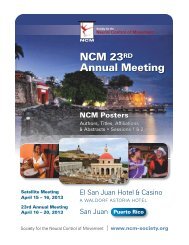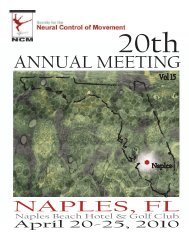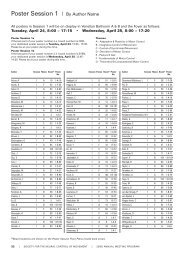2012 Program - Society for the Neural Control of Movement
2012 Program - Society for the Neural Control of Movement
2012 Program - Society for the Neural Control of Movement
You also want an ePaper? Increase the reach of your titles
YUMPU automatically turns print PDFs into web optimized ePapers that Google loves.
PANEL Session 8<br />
Thursday, April 26<br />
8:00 – 10:15<br />
<strong>Neural</strong> mechanisms at <strong>the</strong> basis <strong>of</strong> action<br />
observation, motor simulation and action<br />
prediction: What have we learned in <strong>the</strong> past years?<br />
Thierry Pozzo1, Claudia Domingues Vargas2, Valeria della<br />
Maggiore3, Luciano Fadiga4, Charalambos Papaxanthis5 1Istituto Italiano di Tecnologia, 2Universidade Federal de Rio<br />
de Janeiro, 3University <strong>of</strong> Buenos Aires, 4University <strong>of</strong> Ferrara<br />
and The Italian Institute <strong>of</strong> Technology Genova, 5Université de<br />
Bourgogne and RCBS Dept IIT Genova<br />
Convergent studies indicate that <strong>the</strong> human motor system can be<br />
activated by <strong>the</strong> observation <strong>of</strong> actions <strong>of</strong> o<strong>the</strong>r individuals. Similar<br />
effects <strong>of</strong> motor facilitation have also been found during motor<br />
imagery, i.e. <strong>the</strong> kines<strong>the</strong>tic imagination to per<strong>for</strong>m an action. Given<br />
that <strong>the</strong>se phenomena have been proved to facilitate motor learning,<br />
<strong>the</strong>y are currently <strong>of</strong> great potential in <strong>the</strong> implementation <strong>of</strong> <strong>the</strong>rapies<br />
oriented at <strong>the</strong> recovery <strong>of</strong> sensorimotor function following cerebral<br />
injury. Neuroimaging data suggests that action observation and action<br />
simulation, although, respectively, passively and actively evoked,<br />
share similar neural substrates. In this symposium we intend to<br />
explore fur<strong>the</strong>r <strong>the</strong> neural mechanisms at <strong>the</strong> basis <strong>of</strong> <strong>the</strong>se<br />
phenomena based on novel findings from a team <strong>of</strong> specialists in <strong>the</strong><br />
neuroscience <strong>of</strong> human motor control coming from Latin America,<br />
France and Italy. We will discuss data ga<strong>the</strong>red from approaches that<br />
are in favour and against this view and how <strong>the</strong>se findings fit within<br />
<strong>the</strong> frameworks <strong>of</strong> motor prediction and <strong>the</strong> mirror neuron (MN)<br />
system and how a MN based mechanism may subserve<br />
communication and language. T Pozzo, will introduce <strong>the</strong>se topics and<br />
<strong>the</strong> 4 speakers: C Papaxanthis will present behavioural and TMS<br />
results concerning motor imagery and action observation. Functional<br />
similitudes between <strong>the</strong>se two elusive mental phenomena will be<br />
discussed, in particular <strong>the</strong>ir association to <strong>for</strong>ward internal models<br />
and to <strong>the</strong> actual state <strong>of</strong> <strong>the</strong> body. C Vargas will present behavioural<br />
and electroencephalographic findings on <strong>the</strong> ability to anticipate<br />
actions per<strong>for</strong>med by o<strong>the</strong>rs. She will explore how inference<br />
mechanisms allowing <strong>the</strong> detection <strong>of</strong> transiently hidden actions and<br />
<strong>the</strong> discontinuity <strong>of</strong> visual input could constrain <strong>the</strong> observer to recall<br />
implicit action representations, thus <strong>for</strong>ecasting <strong>the</strong>ir unfolding. The<br />
neural underpinning <strong>of</strong> predicting upcoming actions will also be<br />
explored by showing that lesions in <strong>the</strong> parietal but not <strong>the</strong> premotor<br />
cortex affects this capacity. V Della-Maggiore will present convergent<br />
findings from CSE and fMRI supporting <strong>the</strong> hypo<strong>the</strong>sis that action<br />
observation originates from sensorimotor learning. She will propose<br />
an alternative view to <strong>the</strong> existence <strong>of</strong> a specialized mirror system<br />
relying on <strong>the</strong> neural machinery supporting motor control, learning<br />
and memory. Thus, motor resonance induced by action observation<br />
could simply be explained by <strong>the</strong> retrieval <strong>of</strong> <strong>the</strong> motor program<br />
associated with <strong>the</strong> observed action and its covert activation. In<br />
addition, she will discuss her recent findings supporting that motor<br />
resonance induced by action observation may indeed act as a neural<br />
interface <strong>for</strong> action understanding. L Fadiga will present evidence<br />
from fMRI, TMS and human patient data in favour <strong>of</strong> a functional role<br />
played by action representation in <strong>for</strong>ming <strong>the</strong> basis <strong>for</strong> a supramodal<br />
syntax. Thus, language may have evolved from more basic<br />
sensorimotor circuits already present in lower primates. During<br />
implicit/explicit interaction between individuals <strong>the</strong> motor involvement<br />
is bidirectional and communicative in nature, because <strong>of</strong> <strong>the</strong> mirror<br />
properties <strong>of</strong> <strong>the</strong> motor system. In disagreement with some<br />
interpretations, he will present evidence that <strong>the</strong> sensorimotor<br />
representation <strong>of</strong> o<strong>the</strong>rs’ actions does not require mentalistic or<br />
cognitive mediation being <strong>the</strong> result <strong>of</strong> a hardware link between<br />
premotor and parietal areas.<br />
INDIVIDUAL PRESENTATIONS III<br />
Session 9<br />
Thursday, April 26<br />
10:45 – 12:05<br />
Predicting and correcting human ataxia using a<br />
model <strong>of</strong> cerebellar function<br />
Nasir Bhanpuri1, Allison Okamura2, Amy Bastian3 1Johns Hopkins University, 2Stan<strong>for</strong>d University, 3Kennedy Krieger<br />
Institute, Johns Hopkins School <strong>of</strong> Medicine<br />
The movements <strong>of</strong> patients with damage to <strong>the</strong> cerebellum are ataxic,<br />
i.e. uncoordinated and dysmetric (patients over- or undershoot<br />
targets). It has been hypo<strong>the</strong>sized that <strong>the</strong> cerebellum houses an<br />
internal dynamic model that normally relates motor commands to<br />
changes in body state (e.g. arm position and velocity). We proposed<br />
that when <strong>the</strong> cerebellum is damaged, <strong>the</strong> resulting ataxia is caused<br />
by a mismatch between <strong>the</strong> brain’s modeled dynamics and <strong>the</strong> actual<br />
body dynamics. We studied people with and without cerebellar<br />
damage as <strong>the</strong>y per<strong>for</strong>med single-jointed reaches in an exoskeleton<br />
robot that could render specific dynamic changes to <strong>the</strong> arm (e.g.<br />
increasing or decreasing inertia). We use behavioral and<br />
computational approaches to demonstrate that specific cerebellar<br />
deficits result from a mismatch in internal versus actual arm<br />
dynamics. Our patient model, which includes a feed<strong>for</strong>ward internal<br />
model, body dynamics, and sensory feedback, can predict individual<br />
patients’ dysmetria due to specific biases <strong>of</strong> internal model inertia<br />
estimates. In addition, we are able to reproduce patient-like deficits in<br />
behavior <strong>of</strong> controls by unexpectedly modifying arm inertia--<strong>the</strong>reby<br />
imposing a mismatch between <strong>the</strong> actual and internal estimates <strong>of</strong> <strong>the</strong><br />
arm. Fur<strong>the</strong>rmore, <strong>the</strong> same computational framework can be used to<br />
simulate control behavior <strong>for</strong> a variety <strong>of</strong> unexpected perturbations<br />
(i.e. increased/decreased inertia/viscosity). Last and most importantly,<br />
<strong>the</strong> application <strong>of</strong> patient-specific compensations results in an<br />
improvement <strong>of</strong> <strong>the</strong>ir reaching. Specifically, inertia reduction <strong>for</strong><br />
overshooters (n=5) caused a significant decrease in overshoot<br />
(p










